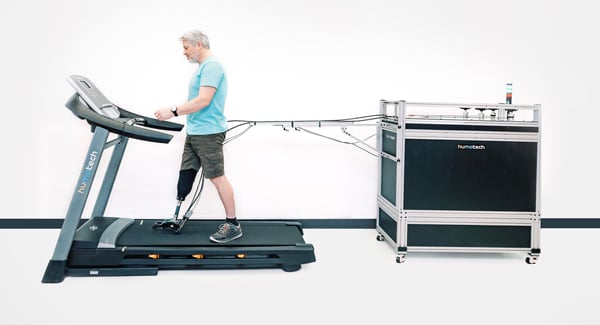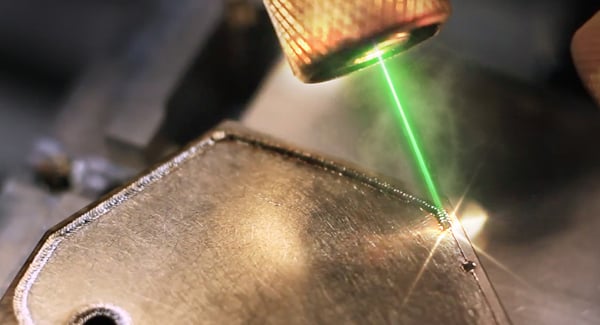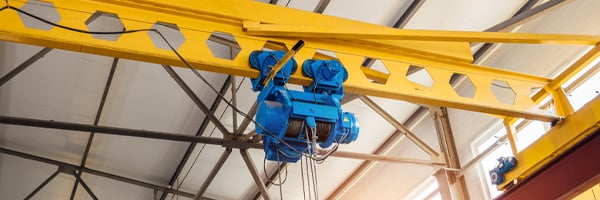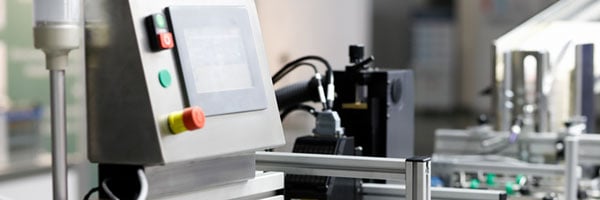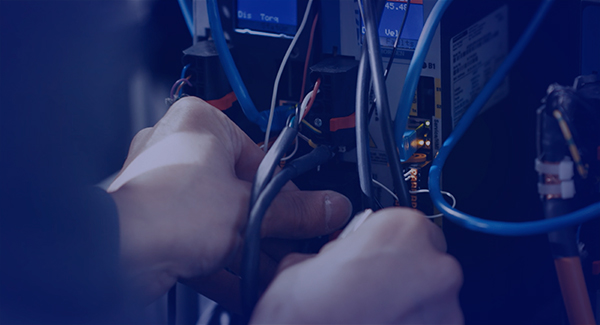AC PM Servo Drive Amplifiers
Different Servo Motor Phase and Commutation Alignments

The issues with commutation alignment between servo motors and servo drives, especially when the motor and drive are from different manufactures, can be quite challenging. Understanding typical design challenges can help you tackle motor phase-sequencing issues.
We will start by identifying or confirming the identification of a servo motor’s leads. Then we will move to the confirmation of the specific lead identification of the phases for a new drive; one in which firmware function labels have not been verified to the outside world. This method will allow us to go through a series of questions, to engage the reader who wishes to better understand the basic issues of commutation alignment.
Question A (Motor Related):
How can we confirm a manufacturer’s Phase identification for their permanent magnet (PM) AC servo motor?
The best way to describe this is with the utilization of an oscilloscope (OSC); but first we will set the Ground Rules:
- Herein we will identify the motor phase nodes as: A, B, & C (A, B, C); where the Bemf voltage at phase-A leads phase-B by 120°; phase-B leads phase-C by 120°; and phase-C leads phase-A by 120°, relative to a defined direction of rotation of the motor’s rotor. [Note: These phases/nodes could just as easily be identified as R, S, T or U, V, W, et cetera].
- We will also identify: phase-A, as the motor phase in which the feedback alignment is referenced; thus making it the motor’s anchor phase.
- Since the phases: A, B, C identify physical leads/nodes of the motor’s Bemf or power source, we will identify the first positive or positive going nodal voltage as phase-A, relative to all other node voltages. This will present a fixed starting point of the anchor phase, as if power was just applied and always started with phase-A, relative to all other phases, from which we will here in communicate.
- Thus, this phase-A voltage will be the positive leading voltage on every initial sequence under consideration, whether we are looking at the Bemf of a motor or the power source to a motor.
Phase: A, B, C, clockwise (CW) rotation, relative to a given direction of rotation of the motor’s rotor, whether the reference is established by looking into the lead exit end of the motor or by its typical opposite end (the torque endbell), does not matter as long as we are consistent.
For this writ we will use phases: A, B, C for a clockwise (CW) rotation as viewed looking into the lead exit end of the motor.

A servo motor’s phase identification can be easily achieved with a dual-channel oscilloscope (OSC) by checking the relative relationship of the motor’s phases (Bemf waveforms) with the defined rotation of the rotor. For complete instructions of how this can be accomplished refer to Appendix: A.
Your motor phases have now been successfully identified and labeled: A, B, C by finding how the Bemf node voltages relate to each other: VAB, VBC, VCA, VAB, VBC, etc., as the servo motor’s rotor is rotated in its manufacturer’s defined direction (In this example CW - looking into the lead exit end or typical rear endbell of a housed servomotor).
- Note: The node: VAB or VAB, should be read as the voltage at node: A, with respect to node: B. Additionally each node is labeled for future reference, with only one specifically identified letter [There is a reason for this!].
Question-B (Drive Related):
We have just designed a new servo drive, and wish to maintain feedback commutation offsets and alignments, such that harmony (feedback commutation angles, etc.) between our products is consistent; can you explain the best procedure for this?
That is a really good question; and, at least in this case, it is clear that we had a permanent magnet (PM) AC synchronous motor in which we want to drive as a servo, before we had a drive. But first, so the question may be answered, we will need to establish some Ground Rules:
- Your past products: motors and drives, are in line with the identification methods of the motor phases as a function of the motor’s Bemf generated when rotated in a defined direction;
- A specifically identified phase (an anchor [P1 herein]) is identified with the feedback device; and this specifically identified anchor supply phase will have a positive leading voltage on every initial sequence under consideration; as if power was just applied and always started with said anchor phase, relative to all other phases (for our communication);
- Note: The circling phases as they are identified and powered, is why we must define one phase as an anchor, from which the hardware/software/firmware is designed and referenced.
- For the purposes herein, we will define our drive phases as P1, P2, & P3 for a positive direction of rotation. Thus, the power supply for said positive direction of rotation: output phase-P1 leads P2 by 120°; phase-P2 leads P3 by 120°; and P3 leads P1 by 120°;
- Note: It is desirable to have servo drive phases labeled (for released product): A, B, C (same as motor). However, until our programing within the drive has been confirmed, we are assigning the drive’s output phases as P1, P2, & P3, where P1 is the drive’s anchor phase from which all hardware/software/firmware is designed and referenced with the expected feedback signal, internal to the drive.
- We will also assume the drive expects to see a feedback signal counting up (positive) for the defined positive direction rotation (#3, above) of the supplied phases; and for the purposes of this answer, this positive commutation direction (#3, above), is the same as the motor’s defined commutation (CW) direction and all feedback connections are functionally the same as your previous drives and motors [as they should be].
- Note: The needed commutation angle setting within the drive is utilized relative to the feedback alignment between feedback hardware and the motor’s phases. However, it is also a function of how the firmware/software within the drive is written, the number of motor pole pairs (electrical cycles) within one 360° rotation of the motor’s rotor, in addition to its original feedback alignment relative to motor phases.
One of the most likely upfront mistakes is to assign the drive phases: A, B, C with no intermediary step (P1, P2, P3) to confirm correct labeling and function; or, to assign the drive phases: A, B, C with no upfront specific determination of how the motor needs to be supplied power in order for it to rotate in its defined direction.
In this case it would be common & conceivably logical for the drive designer to establish the drive’s software, firmware, and physical circuitry such that a positive electrical rotation would present an output effectively placing a positive voltage at the proposed motor’s anchor: Phase-A [our P1], relative to Phase-B [our P2], then Phase-B [P2] relative to Phase-C [our P3], then Phase-C [P3] relative to Phase-A [P1], with expected feedback for said positive electrical source rotation: counting up (positive), and commutation phasing set with phase- P1 being the drive’s anchor.
However, when the drive phases are assigned up front in this manner the prima facie (first impression) drive-to-motor connections are: A to A, B to B, & C to C.
This will quickly expose the connection fallacy by the system not working! Why?
Because the supply voltages need to be presented to each subject motor phase opposite the motor’s generated Bemf (for that same defined direction of rotation), as used to determine the individual motor phase (single letter) identification. We found motor phases: A, B, C by the defined direction of rotation and by the motors Bemf: VAB, VBC, VCA, VAB, VBC, etc. (a method utilized throughout the servo industry); however for this counter emf (Bemf) to appear in opposition to the supplied power (for the defined direction of rotation), the drive’s output phase voltages must be presented to the motor as: VAC, VBA, VCB, VAC, VBA, etc. [against the Bemf of the motor]. Thus, from the standpoint of our defined anchor phase we must switch its reference, and not the anchor phase.
- Note: The node: VAC or VAC, is read as the voltage at node: A, with respect to node: C; This also demonstrates why only a single letter is used to define a specific motor & drive, phase once appropriately defined.
The other item that is absolutely critical to maintaining commutation harmony between products is the identified drive Phase Anchor (P1, herein) for matching up with the motor’s Phase Anchor (Phase-A). It is important to note that the drive phase-P1 does not have to be the anchor; in reality, one would want to assign the drive’s anchor phase in harmony with the anchor phase of the motor for-which commutation alignment is to be maintained.
A perceived correction of this fallacy may be to switch Motor phase connections: A & B, at the drive; but this will mismatch the motor’s anchor phase [A] against the drive’s anchor phase [P1], and produce a commutation phase angle offset of +/- 120 degrees against all previously manufactured motor-drive product line combinations; thus it does not meet our original requirements.
- Notes:
- Switching motor phases: A & B, is a common practice in the electrical industry for changing direction of rotation of an AC induction motor.
- This solution is also undesirable due to the desire to have all drive connection labels inline: A, B, C for example (not: B, A, C), as they appear on the drive; and just relabeling connections: B, A, C to ‘A, B, C or C, B, A’ maintains an undesirable commutation phase angle offset against all previously manufactured motor-drive product line combinations (unless corrected within the drive’s software/firmware or by the circuit layout).
So, what would be the best way to correct or avoid this initial fallacy?
First, let’s return to the common & conceivably logical case of the drive designer establishing the drive’s software, firmware, and physical circuitry such that a positive electrical rotation would present an output effectively placing a positive voltage at the drive’s initially labeled output phase-P1 relative to P2, then Phase-P2 relative to Phase-P3, then Phase-P3 relative to Phase-P1, with expected feedback for said positive electrical source rotation: counting up (positive), with the established anchor phase being P1.
Assuming our initial drive-to-motor connections are, the same except labeling: P1 to motor phase-A, P2 to motor B, & P3 to C, we will produce the same fallacy. So, what is the best way to correct and maintain the anchor phase of the drive (P1) and the established motor anchor phase-A?
Answer: We flip, the drive’s reference phase (P2, connecting it to motor phase-C) such that the drive’s supplied voltage is presented against the motor’s Bemf allowing the first phase (P1 – Anchor) to be maintained per our Ground Rules (#2). This means drive phase-P3 is connected to motor phase-B, and P1 to motor phase-A is maintained.
Our progression for a final topology would be something like this:

It is important to note that there are multiple connection scenarios that will produce a lack of desired operation during the design of a new drive. These different scenarios end up being of one variation or another, of the one presented above; likely the most important thing that needs to be realized and accomplished during the correction of any labeling mistake will be the alignment of the drive’s anchor phase with the motor’s anchor phase; otherwise there is a +/- 120 degree offset and no possibility of product harmony with older and possibility present product lines.
Additional notes:
- Whether or not the 3rd labeling table [above] requires some software/firmware changes will depend on the specifics of how the software/firmware was originally written or intended to work.
- If Hall-effect (“Halls”) devices are being utilized, their drive association with their specific motor phase will also need to change depending on how the original firmware was written. However, if only the source reference for the anchor phase-A is an issue then redefining: Hb (Hall-b) to be H_P3, Hc to be H_P2, may complete the fix. Otherwise review WP (pages T20-T22): Servo Motor Phasing with Hall Commutation

Observations
Product harmony between products should help sustain and improve product quality & safety, and ensure technology compliance between customers and suppliers, for sustainable design and manufacturing practices. The identified anchor phase during design should be as fixed in concrete as the Sword of the Stone is, for a non-rightful claiming king; thus, if the sword is moved, it moves with the stone, it being fixed within!
Conclusion
Of course, there are many ways to mix and match motor phases, hall signal feedback, resolvers, and other feedback devices, to get a working system. Manufacturers presenting a logical relationship between identified phases at the drive & motor, with all feedback types, will take less time to understand and setup by the straight forwardness of the signals & connections. This will also enhance the implementation of mix & matched products, additional features and corrections of any bugs, of the controller/drive firmware and/or HMI software, leaving a positive perception of the supplier and manufacturer.
Appendix: A
In order to determine motor phase labels: A, B, C while maintaining the Ground Rules (1st page), we will use a dual channel oscilloscope (OSC) and the Bemf (Back or Counter, electromotive force) of the Permanent Magnet (PM) AC servo motor as an alternator [monitoring the voltage waveforms generated relative to each other], by physically rotating the rotar by hand.
Instructions
- Label Phase-A, of the motor per manufacture’s documentation. This Phase-A label is now your anchor or stake in the ground (do not change or remove, the Phase-A (anchor) label).
- Connect Channel 1 of the dual-channel Oscilloscope (OSC) to Phase-A.
- Invert (INV) Channel 2, of the OSC and connect either of the two remaining motor phases/wires to Channel 2.
- Connect the ground clips of both OSC probes to the remaining motor phase lead/terminal.
- Set OSC Coupling (both channels) to DC, and Channel 1 as the trigger for the capture of the OSC traces with a positive going edge (a positive going trigger just above zero should work just fine).
- To start: Set the OSC Channel 1 & 2, time base between: 5-40m seconds per division and Channel 1 & 2, amplitude between: 2-20 volts per division, then adjust as needed for steps: 7.
- Rotate the motor’s shaft in the CW direction; given for this example - looking into the lead exit end of the motor (typically the rear endbell of a housed motor).
- This means that if you are looking into the opposite end (the mounting end bell) of the motor, you will need to rotate the shaft/rotor CCW, to maintain harmony with our example.
- Note: You will need to do this over and over (multiple times for the best scope rendering) while adjusting the OSC volts/division and time base, settings.
- After adjusting the OSC’s time base and voltage amplitude, you should get a scope plot that looks similar to Figure-B (without the green dotted line).
Note: If available, the utilizing of an OSC’s capture & hold feature can be very helpful at this stage.
-
- If your present Bemf waveforms look like Channel 1 (blue) leading red relative to channel 2, figure B above; label the wire going to Channel 2 as Phase-C, and the wire connected to the OSC ground clips as Phase-B.
- If your Channel 2 waveform looks like it is shifted to the right over the dotted green line shown above; label the wire going to Channel 2 as Phase-B, and the wire connected to the OSC ground clips as Phase-C.
Poka yoke [double check]:
For 9 (1) above, switch the wires between the OSC ground clips and Channel 2, and verify the waveforms now look like Channel 1 (blue) and 2 (red), [9 (1) above]; if not, you have made a mistake somewhere along the line. [e.g. Make sure you are rotating the rotor in the correct direction.]
Your motor phases have now been successfully identified and labeled: A, B, C by finding how the node voltages relate to each other: VAB, VBC, VCA, VAB, VBC, etc., from the motor’s Bemf as the servo motor’s rotor is rotated in its defined direction (In this example CW - looking into the rear endbell).
- Note: The node: VAB or VAB, should be read as the voltage at node: A, with respect to node: B; additionally, each node is labeled for future reference, with only one specifically identified letter [There is a reason for this!]
About the Author
 Hurley Gill is Senior Applications / Systems Engineer at Kollmorgen located in Radford, VA. He’s a 1978 Engineering Graduate of Virginia Tech who has been engaged in the motion control industry since 1980. He can be reached at [email protected].
Hurley Gill is Senior Applications / Systems Engineer at Kollmorgen located in Radford, VA. He’s a 1978 Engineering Graduate of Virginia Tech who has been engaged in the motion control industry since 1980. He can be reached at [email protected].
About Kollmorgen
Since its founding in 1916, Kollmorgen’s innovative solutions have brought big ideas to life, kept the world safer, and improved peoples’ lives. Today, its world-class knowledge of motion systems and components, industry-leading quality, and deep expertise in linking and integrating standard and custom products continually delivers breakthrough motion solutions that are unmatched in performance, reliability, and ease-of-use. This gives machine builders around the world an irrefutable marketplace advantage and provides their customers with ultimate peace-of-mind.
For more information contact us, email [email protected] or call 1-540-633-3545.







